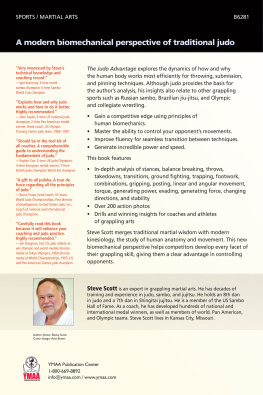
Kinesiology For Dummies
Published by: John Wiley & Sons, Inc., 111 River Street, Hoboken, NJ 07030-5774, www.wiley.com
Copyright 2014 by John Wiley & Sons, Inc., Hoboken, New Jersey
Published simultaneously in Canada
No part of this publication may be reproduced, stored in a retrieval system or transmitted in any form or by any means, electronic, mechanical, photocopying, recording, scanning or otherwise, except as permitted under Sections 107 or 108 of the 1976 United States Copyright Act, without the prior written permission of the Publisher. Requests to the Publisher for permission should be addressed to the Permissions Department, John Wiley & Sons, Inc., 111 River Street, Hoboken, NJ 07030, (201) 748-6011, fax (201) 748-6008, or online at http://www.wiley.com/go/permissions .
Trademarks: Wiley, For Dummies, the Dummies Man logo, Dummies.com, Making Everything Easier, and related trade dress are trademarks or registered trademarks of John Wiley & Sons, Inc., and may not be used without written permission. All other trademarks are the property of their respective owners. John Wiley & Sons, Inc., is not associated with any product or vendor mentioned in this book.
LIMIT OF LIABILITY/DISCLAIMER OF WARRANTY : WHILE THE PUBLISHER AND AUTHOR HAVE USED THEIR BEST EFFORTS IN PREPARING THIS BOOK, THEY MAKE NO REPRESENTATIONS OR WARRANTIES WITH RESPECT TO THE ACCURACY OR COMPLETENESS OF THE CONTENTS OF THIS BOOK AND SPECIFICALLY DISCLAIM ANY IMPLIED WARRANTIES OF MERCHANTABILITY OR FITNESS FOR A PARTICULAR PURPOSE. NO WARRANTY MAY BE CREATED OR EXTENDED BY SALES REPRESENTATIVES OR WRITTEN SALES MATERIALS. THE ADVISE AND STRATEGIES CONTAINED HEREIN MAY NOT BE SUITABLE FOR YOUR SITUATION. YOU SHOULD CONSULT WITH A PROFESSIONAL WHERE APPROPRIATE. NEITHER THE PUBLISHER NOR THE AUTHOR SHALL BE LIABLE FOR DAMAGES ARISING HEREFROM.
For general information on our other products and services, please contact our Customer Care Department within the U.S. at 877-762-2974, outside the U.S. at 317-572-3993, or fax 317-572-4002. For technical support, please visit www.wiley.com/techsupport .
Wiley publishes in a variety of print and electronic formats and by print-on-demand. Some material included with standard print versions of this book may not be included in e-books or in print-on-demand. If this book refers to media such as a CD or DVD that is not included in the version you purchased, you may download this material at http://booksupport.wiley.com . For more information about Wiley products, visit www.wiley.com .
Library of Congress Control Number is available upon request
ISBN 978-1-118-54923-0 (pbk); ISBN 978-1-118-54924-7 (ebk); ISBN 978-1-118-54925-4 (ebk); ISBN 978-1-118-54926-1 (ebk)
Manufactured in the United States of America
10 9 8 7 6 5 4 3 2 1
Chapter 1
Introducing Kinesiology: The Science of Movement
In This Chapter
 Identifying the fields within kinesiology
Identifying the fields within kinesiology
 Grasping the concept of a systems approach to the control of the body
Grasping the concept of a systems approach to the control of the body
 Studying the many aspects of movement
Studying the many aspects of movement
 Evaluating whether this career is a good fit for you
Evaluating whether this career is a good fit for you
T he human body was made to move. Your health depends on it, your survival is supported through it, and your ability to engage and interact with the world requires it. Kinesiology is the science behind movement, and it examines movement in a variety of areas, ranging from health and physiology to biomechanics and sport performance.
Because the human body is complex, the study of movement is complex as well. In this chapter, we offer a quick overview of the science, the field, and the options available to you as a student official or not of kinesiology.
Getting Familiar with Key Areas of Study
Kinein is a Greek word meaning to move, and the study of movement is the foundation of the wide-ranging field of kinesiology. Kinesiology covers a broad array of disciplines that examine the human body at rest, during motion, and as it adapts and changes as a result of motion.
Forming the foundation for kinesiology
Before you can understand how the body moves and adapts to movement, you must understand the human body at rest. These basics knowing important biological processes, explaining the function of the body's structural components and its systems, knowing the chemical reactions that occur in the body, being familiar with principles governing matter in motion, and so on give you a working knowledge of the human body and how it works.
Here's a quick rundown of the subjects you need to know before you get into kinesiology, arranged in a way to give you a glimpse of how the body works:
Next page










 Identifying the fields within kinesiology
Identifying the fields within kinesiology If you want to learn how to train someone to increase muscle growth or bone strength, you really need to know how the muscles and bones are constructed!
If you want to learn how to train someone to increase muscle growth or bone strength, you really need to know how the muscles and bones are constructed!